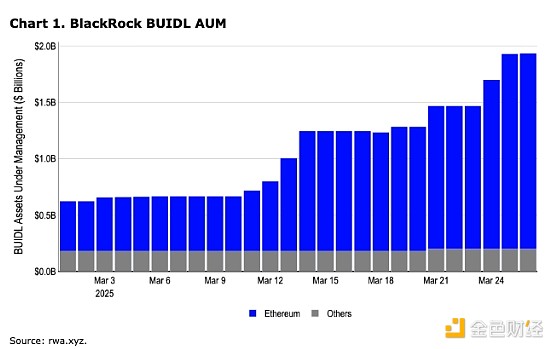
Source: Coinbase; Translated by: Tao Zhu, Golden Finance
SummaryLast week, both cryptocurrency and traditional risk markets performed poorly as participants were paying attention to tariffs that would take effect on April 2.
The regulation of US cryptocurrencies remains strong. President Trump highlighted his focus on U.S. dominance at the Digital Assets Summit, with the SEC hosting the first of five roundtables of the cryptocurrency task force on March 21.
This week is of great significance to stablecoins. The House of Representatives released a draft Stability Act, World Liberty Financial plans to launch a stablecoin backed by U.S. Treasury Investment is testing a stablecoin pegged to the dollar, and Wyoming's multi-chain WYST enters the testnet.
Last week, transactions in cryptocurrencies and traditional risk markets were lighter as participants were waiting for tariffs that took effect on April 2. Nevertheless, market anxiety has increased after President Trump announced on March 27 that it would impose a 25% tariff on all imported cars, while imposing reciprocal tariffs on trading partners. Despite this, the market performed relatively well, but we believe this is mainly due to short cover rather than fundamental trading. BTC, ETH and SOL spot and futures trading volumes on global centralized exchanges remain sluggish, although this is usually when we see portfolio rebalancing at the end of the month to increase liquidity.
Other technical factor leading to wider market activity is GameStop’s announcement of the issuance of $1.3 billion convertible priority bonds (0% interest, due in 2030) for future purchases of Bitcoin as its treasury. In recent months, several publicly traded companies (except Strategy, formerly MicroStrategy) have announced the acquisition of Bitcoin, including Metaplanet, Solidion Technology and Semler Scientific.
At the same time, cryptocurrency regulatory tailwinds remain strong—especially in the United States, as symbolized by President Trump’s speech at the Digital Assets Summit last week, he stressed his focus on the U.S. dominance in the field and drew attention to the ongoing work to pass the stablecoin and market structure bill. In connection, the U.S. Securities and Exchange Commission (SEC) hosted the first of five roundtables of the Crypto Task Force on March 21, focusing on the conditions for defining certain digital assets as securities. These discussions may form the framework of the Crypto Market Structure Act and will have other discussions on topics such as custody, tokenization and DeFi by June 2025. The Senate also recently passed a resolution (by 70 votes) repealing the IRS's DeFi reporting rules and is currently awaiting President Trump's approval.
StableFixed Coins and Multi-chainRegarding stablecoins, the House of Representatives issued the full text of the Stablecoin Transparency and Accountability Promoting Better Ledger Economy Act (STABLE) on March 26, outlining the initial direction of the upcoming legislation. It is worth noting that the bill prohibits the payment of interest or income to stablecoin holders and prohibits the creation of new collateralized stablecoins (i.e., algorithmic stablecoins) within two years. The bill also outlines the issuer's reserve and transparency requirements and creates an approval process for entities seeking to issue new tokens.
At the same time, many other new stablecoins have made progress. World Liberty Financial announced plans to launch its own treasury-backed stablecoin. Fidelity Investment is testing stablecoins (although no plans for launch have been confirmed), and Wyoming is entering the testing phase of its Wyoming Stable Token (WYST). We think Wyoming’s stablecoin launch strategy is particularly interesting because it makes it more powerful to show that despite the current focus on Ethereum, tokenization may be a multi-chain phenomenon in the long run.
Wyoming partnered with LayerZero to launch WYST contracts on Avalanche, Solana, Ethereum, Arbitrum, Optimism, Polygon and Base testnets as its token issuance partner. Similarly, BlackRock expanded its on-chain fiscal fund BUIDL to the Solana blockchain—joining Aptos, Arbitrum, Avalanche, Ethereum, Optimism and Polygon to become a network where investors can access their products. Interest in tokenized fiscal funds has been accelerating, with BUIDL’s AUM increasing by $1.3 billion so far this month (total of $1.9 billion). Although most investors’ interest and liquidity are currently concentrated on Ethereum (90% of the total BUIDL supply is on Ethereum), preemptive branching to different blockchain networks suggests that issuers may be willing to follow users and liquidity if adoption patterns change.
Overview of Crypto Assets and Traditional AssetsCoinbase Exchange and CES InsightsThe cryptocurrency market rebounded. They have been consistent with U.S. stock markets and we see BTC recovering its key 200-day moving average. The Coin 50 index also saw an uptrend, but is still on a downtrend, reflecting the relative weakness of other cryptocurrencies. Unless unexpected economic data are released, we expect range volatility to last at least until April 2, the deadline for President Trump to impose tariffs. Single-digit perpetual financing, recent high stablecoin AUM and short-term future basis screen out low positions as traders wait patiently for further data before addingAdd meaningful risks. Historically, April, May and June were seasonal tough months for crypto assets, so keeping positions low could prove to be a prudent strategy.
Coinbase platform trading volume (USD)
Coinbase platform trading volume by assets
financing rate
Forecast in the next week











